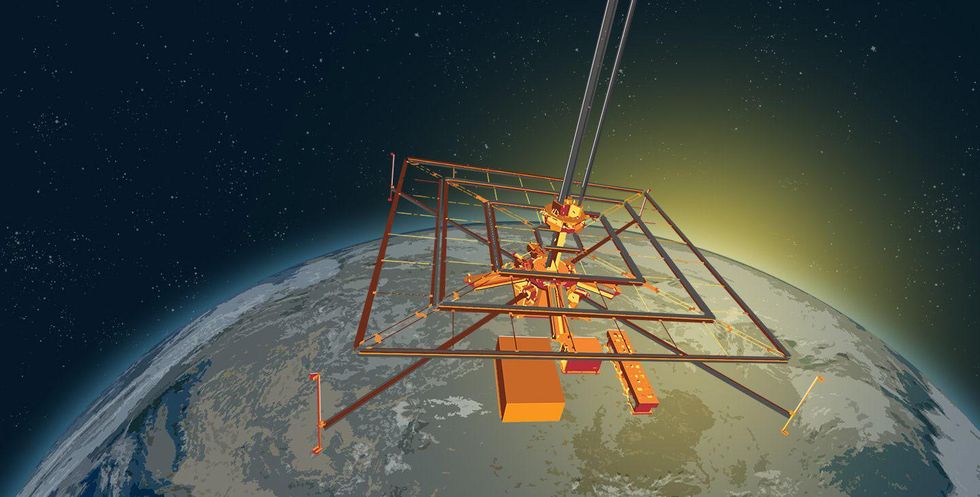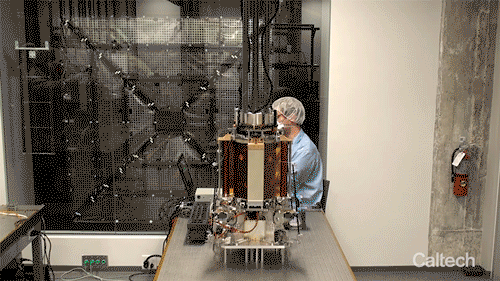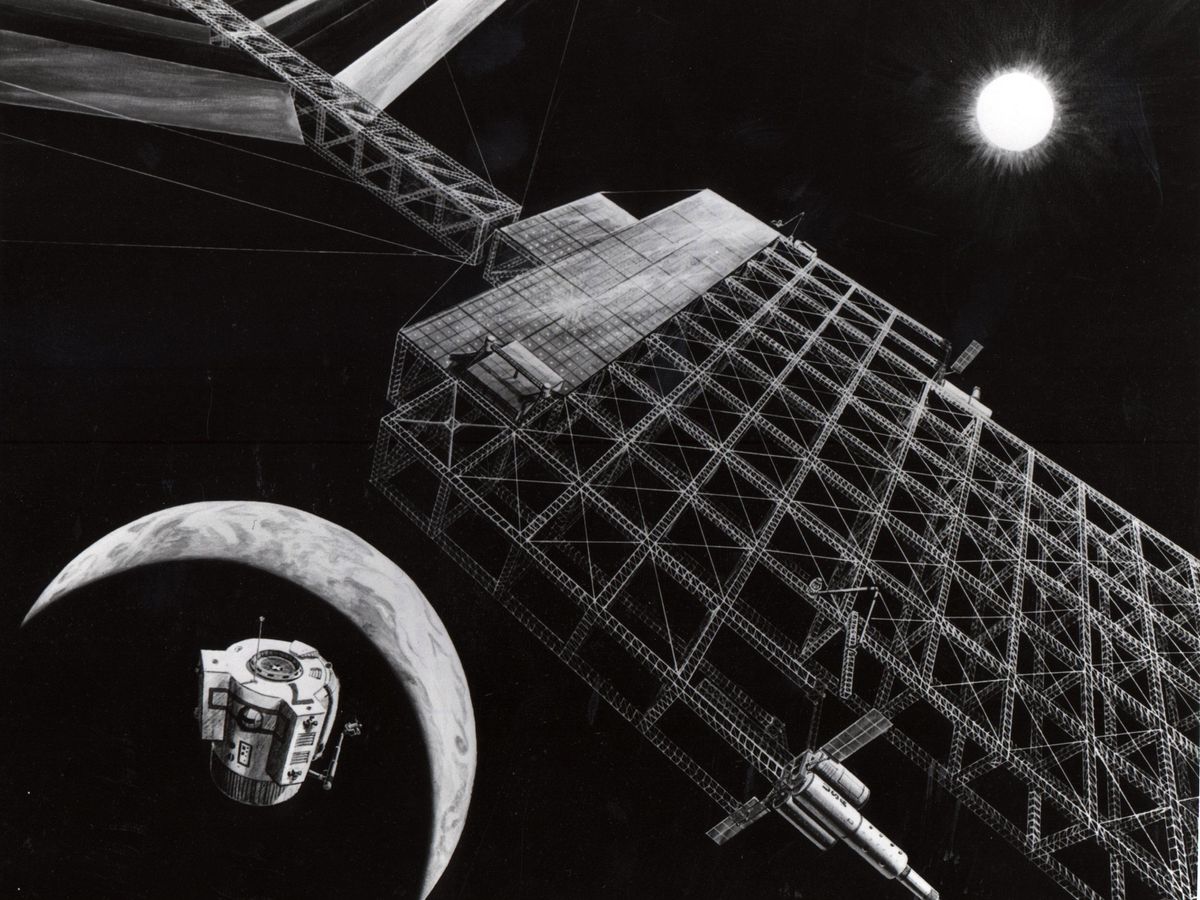For about as long as engineers have talked about beaming solar power to Earth from space, they’ve had to caution that it was an idea unlikely to become real anytime soon. Elaborate designs for orbiting solar farms have circulated for decades—but since photovoltaic cells were inefficient, any arrays would need to be the size of cities. The plans got no closer to space than the upper shelves of libraries.
That’s beginning to change. Right now, in a sun-synchronous orbit about 525 kilometers overhead, there is a small experimental satellite called the Space Solar Power Demonstrator One (SSPD-1 for short). It was designed and built by a team at the California Institute of Technology, funded by donations from the California real estate developer Donald Bren, and launched on 3 January—among 113 other small payloads—on a SpaceX Falcon 9 rocket.
“To the best of our knowledge, this would be the first demonstration of actual power transfer in space, of wireless power transfer,” says Ali Hajimiri, a professor of electrical engineering at Caltech and a codirector of the program behind SSPD-1, the Space Solar Power Project.
The Caltech team is waiting for a go-ahead from the operators of a small space tug to which it is attached, providing guidance and attitude control. If all goes well, SSPD-1 will spend at least five to six months testing prototype components of possible future solar stations in space. In the next few weeks, the project managers hope to unfold a lightweight frame, called DOLCE (short for Deployable on-Orbit ultraLight Composite Experiment), on which parts of future solar arrays could be mounted. Another small assembly on the spacecraft contains samples of 32 different types of photovoltaic cells, intended to see which would be most efficient and robust. A third part of the vehicle contains a microwave transmitter, set up to prove that energy from the solar cells can be sent to a receiver. For this first experiment, the receivers are right there on board the spacecraft, but if it works, an obvious future step would be to send electricity via microwave to receivers on the ground.

One can dismiss the 50-kilogram SSPD-1 as yet another nonstarter, but a growing army of engineers and policymakers take solar energy from space seriously. Airbus, the European aerospace company, has been testing its own technology on the ground, and government agencies in China, Japan, South Korea, and the United States have all mounted small projects. “Recent technology and conceptual advances have made the concept both viable and economically competitive,” said Frazer-Nash, a British engineering consultancy, in a 2021 report to the U.K. government. Engineers working on the technology say microwave power transmissions would be safe, unlike ionizing radiation, which is harmful to people or other things in its path.
No single thing has happened to start this renaissance. Instead, say engineers, several advances are coming together.
For one thing, the cost of launching hardware into orbit keeps dropping, led by SpaceX and other, smaller companies such as Rocket Lab. SpaceX has a simplified calculator on its website, showing that if you want to launch a 50-kg satellite into sun-synchronous orbit, they’ll do it for US $275,000.
Meanwhile, photovoltaic technology has improved, step by step. Lightweight electronic components keep getting better and cheaper. And there is political pressure as well: Governments and major companies have made commitments to decarbonize in the battle against global climate change, committing to renewable energy sources to replace fossil fuels.
Most solar power, at least for the foreseeable future, will be Earth-based, which will be cheaper and easier to maintain than anything anyone can launch into space. Proponents of space-based solar power say that for now, they see it as best used for specialty needs, such as remote outposts, places recovering from disasters, or even other space vehicles.
But Hajimiri says don’t underestimate the advantages of space, such as unfiltered sunlight that is far stronger than what reaches the ground and is uninterrupted by darkness or bad weather—if you can build an orbiting array light enough to be practical.
Most past designs, dictated by the technology of their times, included impossibly large truss structures to hold solar panels and wiring to route power to a central transmitter. The Caltech team would dispense with all that. An array would consist of thousands of independent tiles as small as 100 square centimeters, each with its own solar cells, transmitter, and avionics. They might be loosely connected, or they might even fly in formation.

“The analogy I like to use is that it’s like an army of ants instead of an elephant,” says Hajimiri. Transmission to receivers on the ground could be by phased array—microwave signals from the tiles synchronized so that they can be aimed with no moving parts. And the parts—the photovoltaic cells with their electronics—could perhaps be so lightweight that they’re flexible. New algorithms could keep their signals focused.
“That’s the kind of thing we’re talking about,” said Harry Atwater, a coleader of the Caltech project, as SSPD-1 was being planned. “Really gossamer-like, ultralight, the limits of mass-density deployable systems.”
If it works out, in 30 years maybe there could be orbiting solar power fleets, adding to the world’s energy mix. In other words, as a recent report from Frazer-Nash concluded, this is “a potential game changer.”
This article appears in the April 2023 print issue as “Trial Run for Orbiting Solar Array.”
Ned Potter is a New York writer who spent more than 25 years as an ABC News and CBS News correspondent covering science, technology, space, and the environment.



